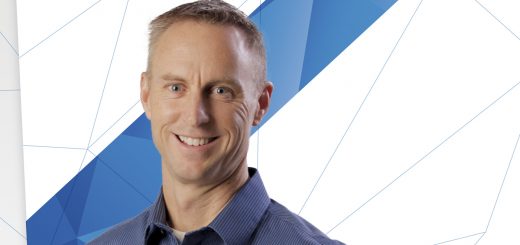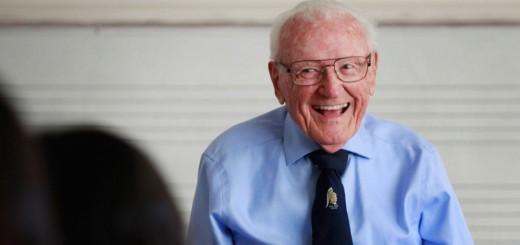Mary Poffenroth, on Equity, Fear and Remote Learning
Biological Sciences Lecturer Mary Poffenroth, ’02 BA, ’06 MS, Biological Sciences, has taught remotely since 2008. “It’s like any art form,” she says. “No one’s going to be an amazing dancer by taking a two-hour dance class!” Faculty members who lean toward perfectionism, she says, mustn’t “expect to be a New York Ballet dancer after a two-hour workshop.” This year as the campus shifted to remote learning, Poffenroth drew from her experience to mentor her colleagues.
Poffenroth teaches groups to creatively deal with fear. In a 2017 TEDx Talk titled “The Myth of Fearlessness,” Poffenroth shared how inescapable fear “can get our attention and motivate us to think and act in a different way.” Her mother’s death, she told the audience, drew her to “see fear as an opportunity, not an obstacle. Fighting and struggling against ourselves trying to be fearless is exhausting.”
Once a first-generation college student, and now an acclaimed SJSU teacher and scholar, Poffenroth is dedicated to making science accessible to all. Here, she talked about teaching and learning during a time of unprecedented challenges.
With your online teaching experience, what do you tell teachers who are new to teaching remotely?
Poffenroth: We usually teach how we were taught—which might be 30 or 40 years ago! Teachers always have student success in mind, but our own experience filter tells us ‘here’s how I learned, so I’m going to teach this way.’ We have a huge opportunity to rethink and redesign. What does the best experience look like in terms of equity? How do we create—as much as possible—a level playing field for all groups?
A decade ago, I figured, I teach 75 minutes in person, I’ll just record that lecture into a 75-minute screencast. No one’s going to watch that—it’s so boring! It’s different when you’re in person, sharing space with other humans. They’re picking up on your facial expressions, your energy, the side stories you don’t tell on camera because you’re so aware it’s being recorded.
We can’t make students sit in front of Zoom six hours a day. They will lose their minds. It’s too much. Last spring, when most faculty were given five seconds to make digital content, it was understandable. But now, given some time to prepare, a totally different experience is possible.
What do you mean by equity? What does it mean when students are learning from home?
Poffenroth: Equity takes many shapes. Is it socioeconomic equity? Ethnic-based equity? Gender equity? First-generation college students? Is it disability access? Can technology start to level the playing field?
For example, at San José State during a ‘normal’ term it’s hard to park! We make things as physically as accessible as possible, but we have old buildings. If you are dealing with mobility challenges, it’s a beast to get to one class, and you’re exhausted after. Digital learning can add some much needed flexibility and efficiency to the day.
That’s just one example among many hidden inequities. San José State’s diverse population of 33,000 students is taking care of parents, kids, or both, and working. That just doesn’t fit into a classic 9 a.m. to 2 p.m. Monday through Friday traditional schedule. We are opening up access to education to people who cannot participate in a very traditional paradigm. Remote learning might be a great solution for working moms, people dealing with health issues, a million different reasons.
But student interaction is important—perhaps even more so for first-generation, underrepresented minorities and historically underserved students. Has it vanished?
Poffenroth: I don’t think people are worried this will replace sharing physical space. It’s going to expand our options, not decrease them. We have an innate, evolutionary-based drive to want to be around other humans.
But teachers can be more thoughtful around communication. Equity means recognizing how people perceive others. I feel that San José State has always been a more supportive community of differences than many other places, but nothing’s perfect. I used to teach Bio 21 on campus to 400 students in one room. Microaggressions probably happened right in front of me, but I didn’t know. In the digital space my students do discussion boards and meet in little subgroups. They’re still interacting, but they know I can tap into all of their work in the learning management system, Canvas. I’m very overt about communication rules: no hate speech, zero tolerance, how to disagree on a topic and still converse in a professional way. So I find that students have many more rich conversations in the digital space on difficult topics than they ever did in the classroom.
Also, in-person classes can introduce inhibiting social factors. For example, a discussion prompt you hoped might elicit thoughtful interactions might get really basic surface responses. There’s all the psychology of interacting with your peers. You don’t want to look stupid. Or maybe the topic is difficult for you, and you don’t want to become emotional in front of people?
Insights students share in the digital space can be amazing. It gives them that time and breadth to dig deeper than in class when put on the spot.
What do you mean by redesigning learning?
Poffenroth: It’s leaving behind the ‘ah ha, gotcha!’ culture. When I was a college student in the 90s, if I missed class, I got punished. If you didn’t get it the first time, too bad! Regurgitate information on the exam to show me you were listening. That’s a punitive system.
Asynchronous instruction—videos or supplemental materials—moves away from punishing students. We’re giving them ways to consume the material that work for them. That’s a big shift from getting in trouble for not doing what I told you to.
Fifty years ago we trained people to do what they were told in a factory: Listen to what I said, do what I said—that’s success. But that ecosystem’s gone. Now we have to train students how to create something out of nothing. The jobs they will have most likely reward this. I want to train you how to think, how to create, how to innovate. That’s my job now—not to make sure you follow my exact directions or get punished if you don’t.
Showing students how to dive into their own learning is essential. Not only in the sciences, but literally every job that allows them to use their brains—they’ll have to learn how to re-skill themselves. To navigate things that don’t even exist yet. So how do we teach them to do that? To be self-motivated learners?
What about the “digital divide”—technological inequities?
Poffenroth: Many of our students don’t have access to good WiFi. Maybe they can’t get the bandwidth to join live on Zoom. Maybe they have cross-generational siblings, a sixth grader and an 11th grader in the house, two parents working and a college student. The WiFi lags when their parents are having to work online now. Some students are on their phones or share a computer. Unless they come from an affluent background, not everyone’s going to have a shiny new computer! So it’s giving some grace to different experiences.
In the past, I required a certain level of reliable connectivity for digital courses. They could always go to campus if they couldn’t access it from home. Now that has evaporated a bit, if you can’t go to campus. We can make accommodations that we wouldn’t have before the coronavirus. We’re trying to grab as many people as possible and bring them across the finish line.
It sounds scary and difficult for everyone.
Poffenroth: One way we short circuit our fear response is to tap into empathy and generosity.
What does it mean to be a first-generation college student this fall? You’ve finally made it! You are your ancestors’ dream! But you don’t get the experience of walking on campus for the first time, saying ‘I made it, Mom and Dad! I’m here!’ You’re actually still at home.
I think about that one student. What’s one way I, as a professor, can empathize? If I make it better for that one student, I’ve made it better for all my students. By increasing empathy and generosity, I’m less focused on my own hyper-aroused survival state.
On day one I might say, ‘I would so much rather be in the lab with you! But here we are! So let’s get through this together. I’m going to make mistakes, and that’s okay, because I’m going to model risk-taking and fixing my mistakes so you can do it too.’ Being honest about our own experience helps reduce personal anxiety.
I spent many years trying to be “perfect”: how I thought a professor should look, act and talk. But that wasn’t authentically me. Especially in the digital space, the more authentically you can communicate to your students the more they connect to you. They connect to you first, and the content second. It’s why we have Bill Nye the science guy: People connect to Bill Nye first as a human, then to the science.
Our students need to see that their professors are human, trying to figure things out. They want to feel that even in the digital space their professors care about them.
We’re all in this weird little boat, and we’re all going to row together.



